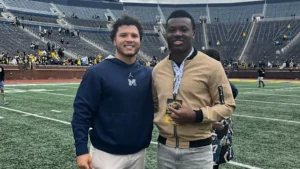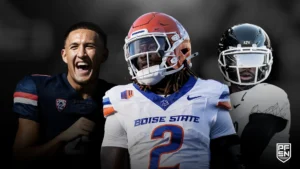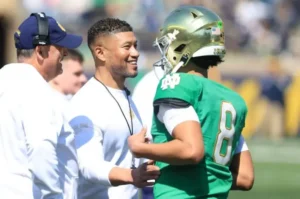
Notre Dame Experiences Their Second Transfer Portal Loss and Counting
In recent years, the transfer portal has become one of the most disruptive and impactful forces in college football. Players are no longer bound to their initial commitments, and schools have had to adapt to a landscape in which rosters can shift dramatically from season to season. The University of Notre Dame, long considered a bastion of stability in the college football world, has found itself in the crosshairs of this new era.
In what has become a familiar theme for many programs across the country, Notre Dame experienced its second significant transfer portal loss recently. While the Fighting Irish have long prided themselves on recruiting and developing talent, the transfer portal has posed a challenge that even the storied program could not fully anticipate. The loss in question may seem like just another player departure, but it serves as a reflection of larger trends that are reshaping the dynamics of college football.
The Transfer Portal: An Overview
Before delving into the specific case of Notre Dame’s transfer portal loss, it’s important to understand the significance of this modern college football phenomenon. The NCAA’s transfer portal, introduced in 2018, allows players to declare their intention to transfer to another school. Unlike previous systems that required a player to receive permission from their current institution, the portal system has made it significantly easier for athletes to explore new opportunities without facing the roadblocks they once did.
This shift has created an environment in which players can leave schools for a variety of reasons—whether it’s to seek more playing time, change of scenery, or simply find a better fit. Schools, too, are using the portal to their advantage, bringing in talent from other programs to address weaknesses or bolster depth.
However, the transfer portal has created new challenges for coaching staffs. On one hand, it has made it easier to bolster a team with immediate contributors, but it also means that rosters are more fluid than ever before. The stability of college football programs, especially those with a proud tradition like Notre Dame, has been tested by the unpredictability that the portal has introduced.
Notre Dame’s Tradition of Stability
Notre Dame is a program that has long been associated with consistency. Its history, rich with championship banners and legendary coaches, is a testament to the enduring success of the Fighting Irish. For years, Notre Dame football has been a symbol of tradition and commitment—commitment to its student-athletes, its alumni, and its broader fan base.
Unlike some other major college football programs, Notre Dame has been somewhat insulated from the instability seen at other schools. The team’s elite recruiting classes and strong in-house development made them an exception to the growing trend of frequent roster turnover. While Notre Dame, like most schools, had occasional player departures, the foundation of their program seemed steadfast.
This stability began to fray as the transfer portal gained momentum, and the trend only accelerated with the departure of key players. For many, the most striking aspect of this shift was how even the most loyal players were now looking elsewhere for opportunities. The reality of college football in the era of the transfer portal is that no program, no matter how storied, is immune to the risks of roster churn.
The First Big Transfer Portal Loss
Notre Dame’s first major transfer portal loss came as a bit of a shock to fans and analysts alike. This was not merely a case of a backup player seeking more playing time at a smaller school. Rather, it involved a key contributor, a player whose absence would create a noticeable hole on the roster.
The loss was a signal that Notre Dame was no longer immune to the trends affecting the broader landscape of college football. As the portal continued to gain traction, it became evident that the Fighting Irish would have to rethink how they approached player retention and recruitment.
Head coach Marcus Freeman, in his early years leading Notre Dame, understood the gravity of the situation. He began emphasizing a stronger focus on keeping players happy, finding ways to better engage with them and providing them with opportunities to grow both on and off the field. However, despite these efforts, the transfer portal still proved to be a formidable force.
The Second Transfer Portal Loss
The second transfer portal loss that hit Notre Dame was particularly impactful, as it came at a position of significant importance. This departure sent shockwaves through the Notre Dame football community, leaving many wondering if the program could continue to maintain its competitive edge in the face of such uncertainty.
This particular player had been a standout contributor during his time at Notre Dame, and his exit left a noticeable gap in the team’s depth chart. While Notre Dame had other capable players to fill the void, the loss of such a talent served as a stark reminder that no one is safe from the lure of the transfer portal.
In some respects, this second loss highlighted a troubling trend: even top-tier programs like Notre Dame are finding it difficult to compete with the financial backing, promises of playing time, and overall allure that other programs can offer through the portal. As players seek new opportunities to advance their careers, the temptation of moving to a program with immediate playing time or better NIL (name, image, likeness) opportunities becomes more difficult to resist.
The Impact of NIL and Transfer Portal Losses
One of the factors that complicates the transfer portal issue is the intersection between NIL deals and the new transfer landscape. While NIL (the ability for athletes to profit off their name, image, and likeness) was a game-changer for college sports, it also created new incentives for players to leave their original schools in search of better deals elsewhere.
For Notre Dame, a program that has historically placed a premium on education and character development, the rise of NIL presents a dilemma. On one hand, the university and football program are committed to the holistic development of student-athletes, including their academic and personal growth. On the other hand, the lure of lucrative NIL opportunities at other programs cannot be ignored, especially for players seeking to maximize their earnings in the face of limited time in college football.
The combination of the transfer portal and NIL has created a dynamic where players have more power than ever before, and schools are forced to navigate a more transactional relationship with their athletes. For Notre Dame, a school with a deep tradition but a somewhat unique position in the college football landscape (due to its independent status and strong academic reputation), this poses a new set of challenges.
Notre Dame’s Response to the Transfer Portal Challenges
As Notre Dame continues to lose talent to the transfer portal, it’s clear that the program must evolve in order to stay competitive. Head coach Marcus Freeman and his staff have taken several steps to address the issue head-on. These measures include:
- Strengthening Player Relationships: Notre Dame is investing heavily in player development, not just on the field, but off it as well. This includes greater engagement with players’ academic and personal needs, with the hope of creating a stronger bond that will reduce the likelihood of transfers.
- Embracing the Transfer Portal: Although Notre Dame has historically relied on high school recruiting, the Fighting Irish are becoming more active in utilizing the transfer portal to bring in talent. By tapping into the pool of players looking for a fresh start, Notre Dame hopes to both replenish its roster and fill gaps left by departures.
- NIL Strategy: Notre Dame is increasingly aware of the need to be competitive in the NIL space. The university and its athletic department have begun exploring ways to offer players opportunities for NIL deals that align with their values and enhance the program’s overall recruitment strategy.
- Adapting Recruiting Tactics: In order to prevent future transfer portal losses, Notre Dame has been adjusting its recruiting tactics to not only find players with talent, but also those who fit the culture and long-term vision of the program. The goal is to recruit players who are less likely to leave after a season or two, as they better align with the values of the university and the football program.
Looking Forward: Can Notre Dame Adapt?
As Notre Dame faces the reality of a changing college football landscape, the program must ask itself some difficult questions: Can the Fighting Irish maintain their competitive edge in an era of constant roster turnover? Will they be able to continue attracting top-tier talent while also keeping their current players happy and invested in the program?
The answer to these questions is still uncertain, but one thing is clear: Notre Dame, like every other program, must adapt. Whether that means embracing the transfer portal as a key part of their recruitment strategy or shifting their focus to building deeper relationships with players, change is inevitable.
While Notre Dame’s second transfer portal loss is certainly a blow, it is also a wake-up call. The Fighting Irish must evolve with the times, ensuring that their program remains relevant, competitive, and a destination for players who are not only looking for a championship, but a lasting, meaningful college experience.
In conclusion, Notre Dame’s second transfer portal loss highlights a broader trend affecting all college football programs. No school, no matter how prestigious, is immune from the disruptive force of the transfer portal and the accompanying rise of NIL. As the Fighting Irish adjust to this new reality, the key to their success will lie in their ability to adapt quickly, innovate, and find ways to ensure their players feel valued and supported both on and off the field.
For Notre Dame, this is not just a challenge—it is an opportunity to grow stronger, smarter, and more resilient in the face of the new era of college football. The question now is not whether they can recover from this latest setback, but how they will use this experience to redefine their future in an ever-changing sport.





